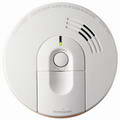Take a look at a typical Smoke Detector installationAfter the circuit is identified and shut off the wires are capped off with wire connectors for an extra measure of safety. |
||
|---|---|---|
| A 3-wire romex is installed to each location linking the detectors together. The wire size must match the existing smoke detector. Even though most detectors do not require a ground, always install and bond the ground conductors together. |  |
 |
 |
 |
|
|
||
 |
 |
 |
|
||
 |
 |  |
|
||
 |
 |
 |
|
||
 |
The power is turned back on and the green power indicator LED lights up. To smoke detector is tested by pressing the test button until the alarm sounds. The alarm usually sounds once then sends the signal to the other smoke detectors causing them to all go into alarm for a short test period. |  |
* Not all smoke detectors are exactly alike, so be sure to carefully read the instruction sheet that came with your brand of smoke detectors. |
||
How to Add More Smoke Detectors

|
Summary: Adding smoke detectors to your home existing smoke detector system will help bring your home up to current codes while providing additional protection to your home and family and adding value to your home as well.
© By: Dave Rongey |
Adding 3-Wire Smoke Detectors to a 2-Wire System
The 2-Wire System - Older Homes Many homes still only have one 2-wire smoke detector usually found in the hallway leading to the bedrooms or a stairwell.
Adding additional smoke detectors in other required areas such as individual bedrooms while converting the original smoke detector is relatively easy, as shown in the installation photos shown below.
A typical construction project will require a smoke detector in each bedroom and on the ceiling or wall at a point centrally located in the area giving access to bedrooms such as hallways.
| Mount smoke detectors at least 4 inches from wall or on the wall with the top of the detector within 4 inches and 12 inches of the highest point of the ceiling. In multi-story units there shall be a detector at each level and shall be placed at the center of the ceiling 24 inches or more higher than the hall are required to have a smoke detector on the hall ceiling and in the bedroom. | In new construction when more than one smoke detector is required to be installed within an individual dwelling, the detectors shall be interconnected in such a manner that the actuation of one alarm will activate all of the alarms in the dwelling. Below you will see some photos of recent projects that I have selected to help you with your project. |
|
|
|
||||||||||
|
The Safest Way to Test Electrical Devices and Identify Electric Wires!The Non-Contact Electrical TesterThis is a testing tool that I have had in my personal electrical tool pouch for years, and is the first test tool I grab to help identify electrical wiring. It is a Non-contact tester that I use to easily Detect Voltage in Cables, Cords, Circuit Breakers, Lighting Fixtures, Switches, Outlets and Wires. Simply insert the end of the tester into an outlet, lamp socket, or hold the end of the tester against the wire you wish to test. Very handy and easy to use.
The Quickest Way to Check for Faulty Electrical Wiring!The Plug-In Outlet TesterThis is the first tool I grab to troubleshoot a problem with outlet circuit wiring. This popular tester is also used by most inspectors to test for power and check the polarity of circuit wiring. It detects probable improper wiring conditions in standard 110-125 VAC outlets Provides 6 probable wiring conditions that are quick and easy to read for ultimate efficiency Lights indicate if wiring is correct and indicator light chart is included Tests standard 3-wire outlets UL Listed Light indicates if wiring is incorrect Very handy and easy to use.
Strip Off Wire Insulation without Nicking and Damaging the Electric Wire!The Wire Stripper and Wire CutterMy absolute favorite wire stripping tool that I have had in my personal electrical tool pouch for years, and this is the tool I use to safely strip electrical wires. This handy tool has multiple uses: The wire gauges are shown on the side of the tool so you know which slot to use for stripping insulation. The end of the tool can be used to grip and bend wire which is handy for attaching wire onto the screw terminals of switches and outlets.. The wire stripper will work on both solid and stranded wire. This tool is Very Handy and Easy to Use. |
||
Residential Electrical Parts and AccessoriesLight Switches 120volt Outlets Circuit Breakers Electrician Tools Voltage Testers |














